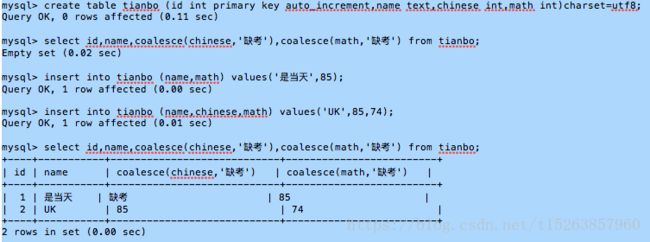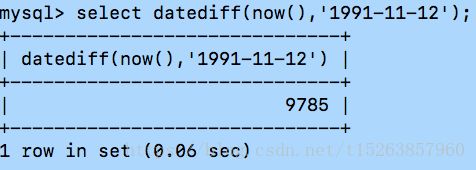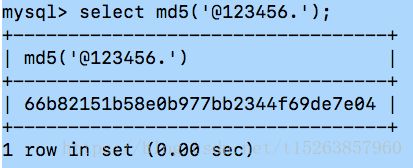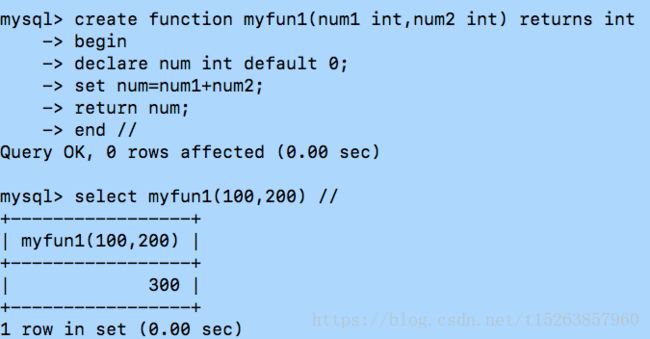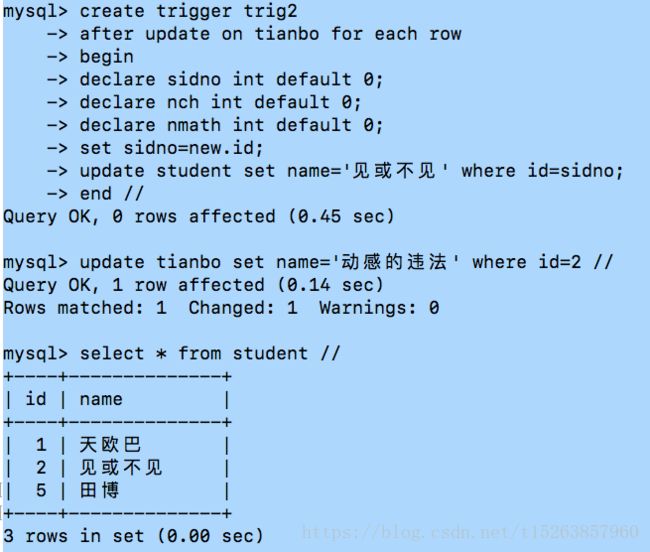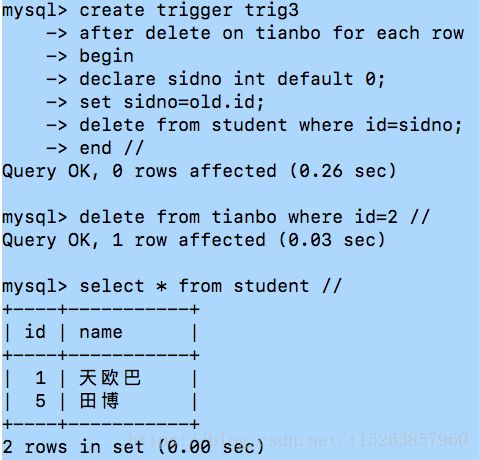数据库的高级应用
一、存储过程简介
1、存储过程简介
SQL语句需要先编译,后执行;
而存储过程(stored Procedure)是一组为了完成特定功能的SQL语句集,经过编译后存储在数据库中,用户通过指定存储过程的名字并给定参数(如果该存储过程带有参数)来调用执行它。
- 数据库中的存储过程可以看做是对编程中面向对象方法的模拟,它允许控制数据的访问方式
- 存储过程是可编译的函数,在数据库中创建并保存,可以由SQL语句和控制结构组成。当想要在不同的应用程序或平台上执行相同的函数,或者封装特定功能时,存储过程是非常有用的。
2、存储过程的优点:
(1)增强SQL语言的功能和灵活性:
存储过程可以用控制语句编写,有很强的灵活性,可以完成复杂的判断和较复杂的运算
(2)标准组件式编程:
存储过程被创建后,可以在程序中被多次调用,而不必重新编写该存储过程的SQL语句。而且数据库专业人员可以 随时对存储过程进行修改,对应程序源代码毫无影响
(3)较快的执行速度:
如果某一操作包含大量批处理的Transaction-SQL代码或分别被多次执行,那么存储过程要比批处理的执行速度快 很多。因为存储过程是预编译的。
在首次运行一个存储过程时查询,优化器对齐进行分析优化,并且给出最终被存储在系统中的执行计划。而批处理 的 Transaction-SQL语句在每次运行时都要进行编译和优化,速度相对要慢一些
(4)减少网络流量:
针对同一个数据库对象的操作(如查询、修改),如果这一操作所涉及的Transaction-SQL语句被组织进存储过 程,那么当在客户计算机上调用该存储过程时,网络中传送的只是该调用语句,从而大大减少网络流量并降低网络负载。
(5)作为一种安全机制来充分利用:
通过对执行某一存储过程的权限进行限制,能够实现对应的数据访问权限的限制,避免了非授权用户对数据的访 问,保证了数据的安全 。
二、存储过程
建库建表
create database tianbo charset=utf8; //创建数据库tianbo;
create table student (id int primary key auto_increment,name text)charset=utf8; //创建表:student
insert into student (id,name) values (1,'天欧巴'),(2,'好困'); //往表里插入两条数据
create table teacher (id int primary key auto_increment,tname text,tage int)charset=utf8; //建表:teacher
insert into teacher (tname,tage) values('天天',24),('珂珂',15); //往teacher表中插入两个数据
1、创建存储过程
(1)分隔符
MySQL默认以";"为分隔符,如果没有声明分割符,则编译器会把存储过程当成SQL语句进行处理,因此编译过程 会报错,所以要事先用“DELIMITER //”声明当前段分隔符,让编译器把两个"//"之间的内容当做存储过程的代码,不会 执行这些代码;“DELIMITER ;”的意为把分隔符还原。
(2)参数的类别
1)参数类型有三种:
输入参数(in):IN参数的值必须在调用存储过程时指定,在存储过程中修改该参数的值不能被返回,为默认值
输出参数(out):OUT:该值可在存储过程内部被改变,并可返回
输入输出(inout):INOUT:调用时指定,并且可被改变和返回
2)过程体
过程体的开始与结束使用BEGIN与END进行标识。
(3)语法:
delimiter ** //将结束符设置为**
create procedure 存储过程名(in/outinout 参数 参数类型,……)
begin
SQL语法; //如果存储过程中就一句SQL语句,begin……end两个关键字,可以省略
end **
delimiter ; //把结束符再设置会‘ ;’
call 存储过程名([参数]); //调用存储过程
例如:
mysql> delimiter //
mysql> create procedure pro1(in param int) #in:代表的是输入参数,可以省略
-> begin
-> select * from student where id=param;
-> end //
Query OK, 0 rows affected (0.00 sec)
mysql> set @param=2; #用户变量一般以@开头,注意:滥用用户变量会导致程序难以理解及管理
Query OK, 0 rows affected (0.00 sec)
mysql> call pro1(@param);
+----+--------+
| id | name |
+----+--------+
| 2 | 好困 |
+----+--------+
1 row in set (0.00 sec)
Query OK, 0 rows affected (0.00 sec)
2、删除存储过程:
语法:drop procedure [if exists] 存储过程名
例如:drop procedure if exists pro1;
3、查看存储过程的信息:
语法:select name from mysql.proc where db=“数据库名”;
select name from mysql.proc where db="tianbo";
+------+
| name |
+------+
| pro1 |
+------+
1 row in set (0.00 sec)
语法: show procedure status where db=“数据库名”;
查询存储过程的详细信息:SHOW CREATE PROCEDURE 数据库.存储过程名;
4、局部变量
语法:declare 变量名 数据类型 [初始值]
通过:select……into……或set命令给变量赋值
例如:通过id查询姓名和年龄
delimiter //
mysql> create procedure pro3(in sid int)
-> begin
-> declare sname text;
-> select name into sname from student where id=sid;
-> select sname from dual;
-> end //
Query OK, 0 rows affected (0.00 sec)
mysql> delimiter ;
mysql> call pro3(1);
+-----------+
| sname |
+-----------+
| 天欧巴 |
+-----------+
1 row in set (0.00 sec)
Query OK, 0 rows affected (0.00 sec)
注意:声明的变量名不能和列名(字段名)同名
5、全局变量(用户变量)
全局变量前面必须有一个@,全局变量的数据类型取决于变量的值。如果一个变量没有赋值,他的数据类型为null;
set @sname=“可以”;
select * from student where name=@name;
6、系统变量:通过两个@@开头的都是系统变量
select @@version from dual;
| 系统命令 | 作用 |
|---|---|
| @@version | 版本号 |
| current_date | 当前日期 |
| current_time | 当前时间 |
| current_timestamp | 当前日期和时间 |
7、带有输出参数的存储过程
mysql> delimiter //
mysql> create procedure pro5(in age int,out result int)
-> begin
-> set result=age*age;
-> end //
Query OK, 0 rows affected (0.05 sec)
mysql> call pro5(15,@result)//
Query OK, 0 rows affected (0.05 sec)
mysql> select @result from dual //
+---------+
| @result |
+---------+
| 225 |
+---------+
1 row in set (0.00 sec)
8、带有输入输出参数的存储过程
create procedure pro6(inout age int)
-> begin
-> set age=age*age;
-> end //
Query OK, 0 rows affected (0.00 sec)
mysql> set @age=10 //
Query OK, 0 rows affected (0.00 sec)
mysql> call pro6(@age)//
Query OK, 0 rows affected (0.00 sec)
mysql> select @age //
+------+
| @age |
+------+
| 100 |
+------+
1 row in set (0.00 sec)
9、SQL编程(了解)
(1)if-elesif-else语句
语法:
if 条件 then
//SQL代码
elseif 条件 then
//SQL代码
end if;
举例:
create procedure pro7(in sid int)
-> begin
-> if sid =1 then
-> select '金牌会员' as '等级';
-> elseif sid=2 then
-> select '普通会员' as '等级';
-> else
-> select '游客' as '等级';
-> end if;
-> end //
Query OK, 0 rows affected (0.07 sec)
mysql> call pro7(3) //
+--------+
| 等级 |
+--------+
| 游客 |
+--------+
1 row in set (0.00 sec)
Query OK, 0 rows affected (0.00 sec)
(2)case-when语句
create procedure pro8(in sid int)
-> begin
-> case sid
-> when 1 then select '看见了健康' as '气质';
-> when 2 then select '屌丝' as '气质';
-> when 3 then select '正常人' as '气质';
-> when 4 then select '贵族' as '气质';
-> else select '输入不正确' as '气质';
-> end case;
-> end //
Query OK, 0 rows affected (0.00 sec)
mysql> call pro8(0) //
+-----------------+
| 气质 |
+-----------------+
| 输入不正确 |
+-----------------+
1 row in set (0.01 sec)
Query OK, 0 rows affected (0.01 sec)
(3)loop循环
create procedure proc(in num int)
-> begin
-> declare total int default 0;
-> declare i int default 0;
-> sign:loop
-> set total =total+i;
-> set i=i+1;
-> if i>num then
-> leave sign; #leave=break
-> end if;
-> end loop;
-> select total from dual;
-> end //
Query OK, 0 rows affected (0.00 sec)
mysql> call proc(100) //
+-------+
| total |
+-------+
| 5050 |
+-------+
1 row in set (0.00 sec)
Query OK, 0 rows affected (0.00 sec)
#如果没有设置标签名,leave loop
#sign是循环名,用于结束循环,可以自己随意取名字
(4)while循环
语法:
while 条件 do
SQL代码
end while
举例:
create procedure pro10(in num int)
-> begin
-> declare total int default 0;
-> declare i int default 0;
-> while num>=i do
-> set total=total+i;
-> set i=i+1;
-> end while;
-> select total from dual;
-> end //
Query OK, 0 rows affected (0.00 sec)
mysql> call pro10(100) //
+-------+
| total |
+-------+
| 5050 |
+-------+
1 row in set (0.00 sec)
Query OK, 0 rows affected (0.00 sec)
(5)repeat循环
语法:
repeat
SQL代码
until 条件 --知道重复到条件为true才结束
end repeat
举例:
create procedure pro11(in num int)
-> begin
-> declare total int default 0;
-> declare i int default 0;
-> repeat
-> set total=total+i;
-> set i=i+1;
-> until i>num
-> end repeat;
-> select total from dual;
-> end //
Query OK, 0 rows affected (0.00 sec)
mysql> call pro11(100) //
+-------+
| total |
+-------+
| 5050 |
+-------+
1 row in set (0.00 sec)
Query OK, 0 rows affected (0.00 sec)
(6)leave和iterate
leave类似于break,iterate类似于continue
举例:
create procedure pro12()
-> begin
-> declare i int default 0;
-> sign:while i<5 do
-> set i=i+1;
-> if(i=3) then
-> leave sign;
-> end if;
-> select i from dual;
-> end while;
-> end //
Query OK, 0 rows affected (0.00 sec)
mysql> call pro12() //
+------+
| i |
+------+
| 1 |
+------+
1 row in set (0.00 sec)
+------+
| i |
+------+
| 2 |
+------+
1 row in set (0.00 sec)
Query OK, 0 rows affected (0.00 sec)
10、内置函数
(1)数字类
| 语句 | 含义 |
|---|---|
| select rand() from dual; | 随机数 |
| select * from student order by rand(); | 随机排序 |
| select round(5.6); | 四舍五入 |
| select ceil(5.3); | 向上取整 |
| select floor(5.6); | 向下取整 |
(2)大小写转换
| 语句 | 含义 |
|---|---|
| select ucase(‘i am lyb’); | 大写 |
| select lcase(‘I AM LYB’); | 小写 |
(3)截取字符串
| 语句 | 含义 |
|---|---|
| select left(‘abcdefg’,3); | 截取左边的3位 |
| select right(‘abcdefg’,3); | 截取右边3位 |
| select substring(‘abcdefg’,2,3); | 从第2位开始取3个字符,起始位置从1开始 |
(4)字符串拼接
select concat(tname,tage) from teacher //
+--------------------+
| concat(tname,tage) |
+--------------------+
| 天天24 |
| 珂珂15 |
+--------------------+
2 rows in set (0.00 sec)
(5)coalesce(str1,str2):如果str1不为null显示str1,否则显示str2
(6)length(字节长度,查的是几个字节)、char_length(字符长度,查的是字符)、trim(去两边空格)、repace(替代)
MySQL 5.0以上的版本:
1)一个汉字占多少长度与编码有关:
UTF-8:一个汉字=3个字节
GBK:一个汉字=2个字节
2)varchar(n)表示n个字符,无论汉字和英文,Mysql都能存入n个字符,仅是实际字节长度有所区别
3)MySQL检查长度,可用SQL语言:
select LENGTH(fieldname) from tablename 来查看
举例:select length('很纠结'); /查的是字节
+---------------------+
| length('很纠结') |
+---------------------+
| 9 |
+---------------------+
1 row in set (0.07 sec)
举例: select replace('pgone','one','two');
+------------------------------+
| replace('pgone','one','two') |
+------------------------------+
| pgtwo |
+------------------------------+
1 row in set (0.06 sec)
(7)时间戳:unix_timestamp
举例:select unix_timestamp();
+------------------+
| unix_timestamp() |
+------------------+
| 1535369254 |
+------------------+
1 row in set (0.02 sec)
(8)将时间戳转化成当前时间
举例:select from_unixtime(354654654);
+--------------------------+
| from_unixtime(354654654) |
+--------------------------+
| 1981-03-29 03:10:54 |
+--------------------------+
1 row in set (0.00 sec)
(9)获取当前时间
(10)dayname(),monthname(),dayofyear()
(11)datediff(结束日期,开始日期)
举例:计算自己活了多少天?
(12)md5():md5加密
三、自定义函数
语法;
create function 函数名(形参)returns 返回的数据类型
begin
//函数体
end
select 函数名(实参);
四、触发器
1、 简介:
(1)触发器是一个特殊的存储过程
(2)不需要直接使用,在MYSQL自动调用
(3)是一个事务,可以回滚
2、触发器的类型(触发事件)
(1)insert触发器
(2)update触发器
(3)delete触发器
3、创建触发器
语法:
create trigger 触发器名称 触发时间 [before][after]触发事件 on 表名 for each row
begin
//代码
end
4、new表和old表
(1)这两个表是个临时表
(2)当触发器触发的时候再内存中自己创建,触发器执行完毕后自动销毁
(3)他们的表结构和触发器触发的表结构一样
(4)只读、不能修改
(5)打开文件,内存中需要加载,会随机分配一个空间用来保存文件的所有数据,-》old
(6)在新的一轮操作后,内存会生成新的空间,这个空间里面保存了新的数据变化-》new
5、insert触发器
#在stuinfo中插入一个值,就会自动在student中插入一条数据
#after insert 表示的是在insert动作执行完毕以后触发
#on stuinfo for each row 针对的stuinfo表,并且可以读取到每一行的变化
#触发器中定义的局部变量不能与表中的字段名一致,否则会发生字段识别问题(识别不出到底是字段,还是变量)
https://blog.csdn.net/beichen0518/article/details/80820335
6、update触发器
7、delete触发器
8、查看和删除触发器
show triggers;
drop trigger if exists trig1;
(了解)五、用户管理
1、创建用户
语法: create user '用户名' @ ‘允许登录的主机地址’ identified by 密码
%代表数据库的库名
create user 'tttttt' @ '%' identified by '123456';
2、删除用户
语法:drop user 用户;
drop user tttttt;
3、增加用户权限
将teacher的所有表的select权限付给tttttt用户
将所有数据库中的所有表的所有权限付给tttttt用户
创建用户并授权
![]()
创建后啊用户以后,刷新mysql用户权限表
![]()
删除select权限
revoke select on teacher.* from 'tttttt'@'%';
删除所有权限
revoke all privileges on *.* from 'tttttt'@'%';

